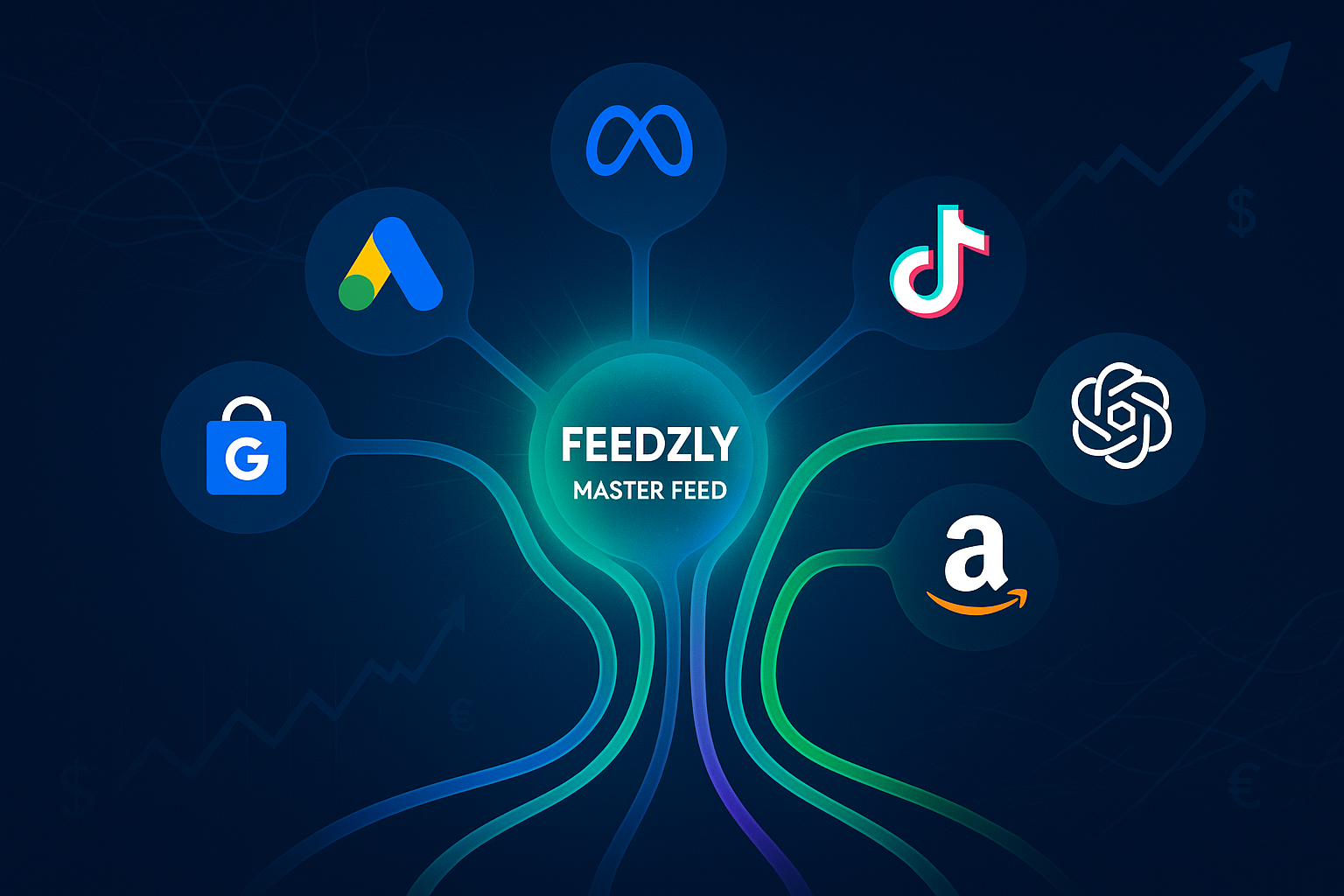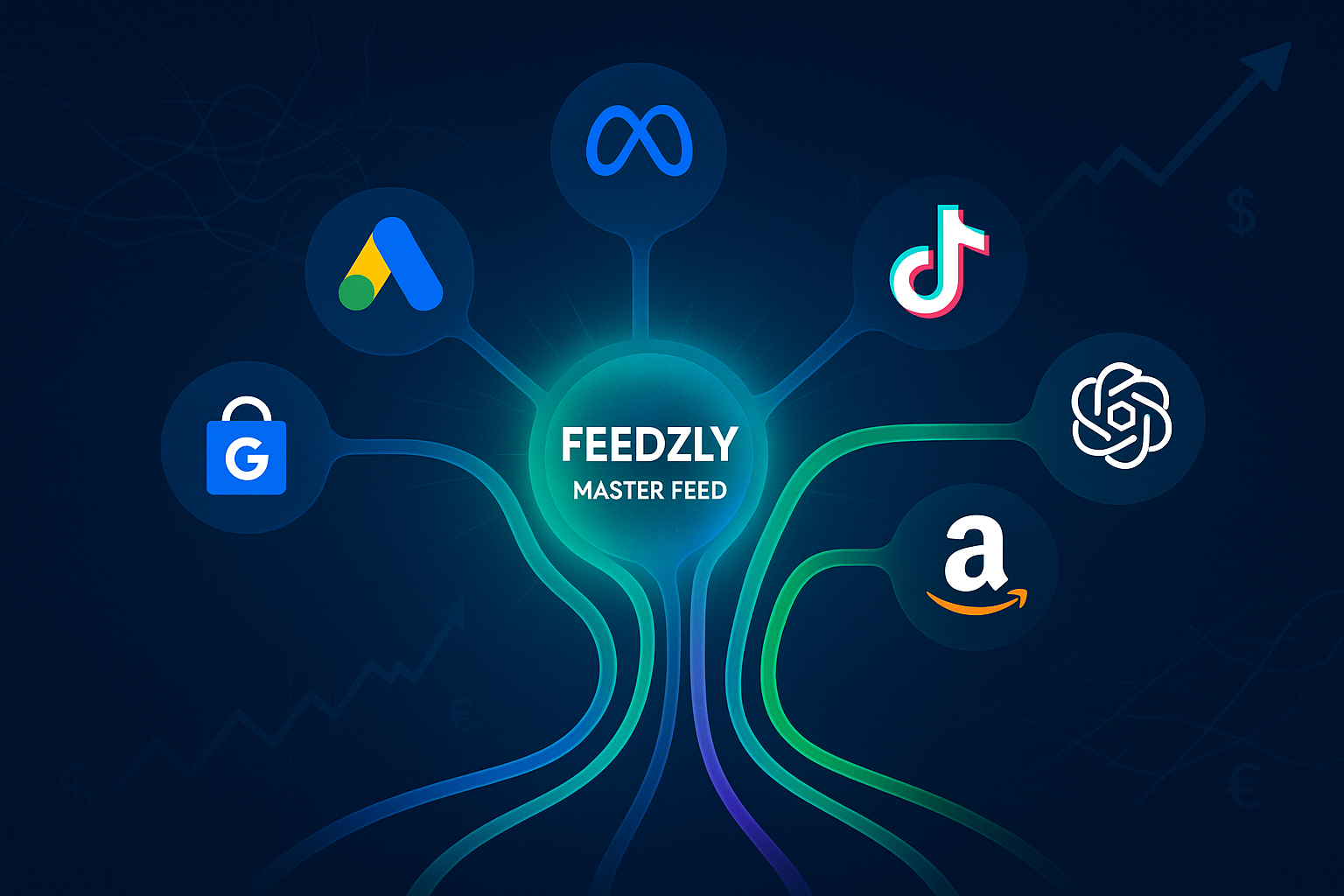
In today’s competitive e-commerce landscape, simply having a product feed isn’t enough. If you’re still relying on one or two generic feeds for all your channels—Google Shopping, Meta Commerce, TikTok, Pinterest, and even emerging LLMs like ChatGPT—you’re not just missing opportunities; you’re leaving revenue on the table.
Optimizing for a single channel is helpful. Optimizing for every channel is transformative. It’s about more than just distributing data—it’s about adapting product information to match the unique demands and user behaviors of each platform.
Done right, this approach unlocks stronger rankings, higher click-through rates (CTRs), more efficient traffic, and ultimately, more conversions.
The challenge? Wrestling with endless adjustments.
That’s where Feedzly helps. Our platform enables high-growth e-commerce brands to generate channel-specific feeds from a single master source, with the flexibility to refine based on performance data.
It’s not just feed management—it’s about building a sustainable advantage for omnichannel growth.
The Anatomy of a High-Performing Feed
At its core, a product feed is a file containing essential details: titles, descriptions, images, prices, and availability. It powers your ads, your marketplace listings, and even how products appear in emerging AI-driven discovery engines.
The difference between a generic feed and an optimized feed is strategic intent. A generic feed lists your products. An optimized feed adapts attributes to resonate with a specific channel’s algorithm and search behaviors.
Generic feeds fall short because they ignore platform quirks—from character limits and taxonomy rules to audience expectations. By maintaining separate, tuned feeds for each channel (all derived from a central master), you gain control over how your products perform across the board.
Decoding Channel Quirks
Each channel has its own rules, algorithms, and audiences. What wins on Google Shopping might flop on TikTok; what works on Meta won’t carry over to Pinterest or LLMs.
Google Shopping & Google Organic
Google remains a cornerstone of product discovery, but “optimization” doesn’t mean ticking every box. What matters is focusing on the levers that actually drive visibility and efficiency for your catalog.
- Titles & Descriptions: Often a high-impact area, but the level of detail should be guided by performance data. Sometimes concise titles outperform long ones.
- Custom Labels: Useful for segmentation (e.g., margin, seasonality), but only mission-critical if you’re actively managing bids or reporting by those dimensions.
- GTINs & MPNs: Helpful for eligibility and matching in certain verticals, but not every product type relies on them.
- Schema Markup: Valuable for organic visibility, though this is typically handled as part of our Shopping AI Pro services, not inside Feedzly itself.
Feedzly’s Advantage: Rather than forcing a rigid structure, Feedzly makes it easy to test and refine attributes like titles, labels, and identifiers.
And for brands that want to extend feed optimization into SEO (including schema implementation), we support that work directly through Shopping AI Pro.
Meta Commerce (Facebook & Instagram)
Visual impact and audience targeting drive performance.
- High-Quality Images: Stand out in crowded feeds.
- Clear CTAs: Simple, action-oriented descriptions.
- Segmentation: Custom labels for specific audiences.
Feedzly makes it easy to create Meta-specific feeds with optimized image references and custom attributes that align with campaign goals.
TikTok Shop
Fast, trend-driven discovery requires agility.
- Concise Descriptions: Quick, engaging copy.
- Trend Alignment: Categories and keywords adapted to what’s trending.
Feedzly supports adjustments that align feeds with TikTok’s unique discovery mechanisms, giving products a better chance of surfacing in shoppable content.
Pinterest Shopping
Pinterest is a visual search engine where inspiration drives intent. Success comes from optimizing for discovery while supporting rich visuals.
- Lifestyle Images: Contextual imagery that shows products in use often outperforms plain cutouts.
- Keyword-Rich Descriptions: Product titles and descriptions that align with how users search for inspiration (“boho living room ideas” vs. just “sofa”).
- Trend & Style Tags: Leveraging attributes around emerging trends and design styles helps products surface in popular searches.
Feedzly’s Advantage: Feedzly makes it simple to enrich Pinterest-specific attributes and ensure feeds emphasize visual and contextual signals that perform best on the platform.
LLMs (ChatGPT, Perplexity, Gemini, etc.)
AI-driven commerce is emerging. Visibility depends on how well product data is structured and described for machines to interpret.
- Semantic Richness: Go beyond keywords to emphasize context and use cases.
- Contextual Attributes: Highlight why a product suits a specific audience or scenario.
- Schema & Structured Data: Typically handled as part of our Shopping AI Pro services, schema helps AI models parse product data for organic visibility.
Feedzly’s Advantage: Feedzly ensures your feed data is consistent, enriched, and organized in ways that make it easier for AI-driven systems to work with. And when deeper SEO/structured data work is needed, we extend that through Shopping AI Pro.
The Hidden Costs of Generic Feeds
Using a single, generic feed introduces avoidable costs:
- Lower CTRs from less relevant ads.
- Higher CPA from inefficient targeting.
- Lost organic visibility due to weak schema.
- Missed revenue when platforms reject or suppress listings.
Optimized feeds can reduce wasted spend and improve ROI significantly. The exact lift varies by catalog and channel, but across industries, brands consistently report higher conversion rates, better CTRs, and lower acquisition costs after moving to channel-specific optimization.
Common Challenges & Smarter Solutions
E-commerce brands often face feed headaches:
- Discrepancies across channels → Confuses shoppers, reduces trust.
- Feedzly provides a single source of truth from which all feeds are derived.
- Out-of-sync pricing or stock → Leads to wasted ad spend and poor CX.
- Feedzly syncs with your product source of record to minimize mismatches.
- Missing attributes → Can cause product rejections or reduced visibility.
- Feedzly makes it easier to enrich attributes across your catalog at scale. And for brands that need hands-on help diagnosing and correcting gaps, we extend support through Shopping AI Pro.
- Manual rework → Time-consuming, error-prone.
- Feedzly applies rules at scale while preserving manual override where it matters.
- Platform disapprovals → Lost sales opportunities.
- Feedzly generates channel-specific feeds to simplify compliance and reduce rejections.
Feedzly in Action
Instead of wrestling with dozens of siloed feeds, Feedzly takes your base platform feed (Shopify, WooCommerce, BigCommerce, or any e-commerce system that provides a product feed) and makes it possible to create and manage tailored versions for each ad platform.
- Base Feed Connection: Start with your platform’s primary feed as the source of truth.
- Channel Setup: Generate and manage separate feeds for each destination—Google, Meta, TikTok, Pinterest, and more—while keeping the base product data consistent across all platforms.
- Custom Rules: Apply adjustments per channel to ensure attributes, titles, and other data fit platform requirements.
- Refine: Ongoing performance-based refinements are available as part of our Shopping AI Pro services, where we help analyze campaign data and guide the next round of optimizations.
This approach keeps feeds centralized in one system while still allowing the flexibility to treat each channel’s requirements individually.
Choosing Your Feed Management Partner
When evaluating solutions, consider:
- Granular control + automation: Can you automate at scale while still refining at the SKU level?
- Channel coverage: Does it support both today’s platforms and emerging ones like LLMs?
- AI capabilities: Does the AI go beyond filler text, actually enhancing data for performance?
- Ease of use: Can your team operate it without heavy developer support?
- Scalability: Will it handle growth from hundreds to hundreds of thousands of SKUs?
- Expertise: Is it built by practitioners who understand real e-commerce challenges?
Many tools offer feed management. Few combine automation, control, and marketer-centric design the way Feedzly does.
Future-Proofing Your Strategy
The e-commerce landscape evolves fast. From cookie deprecation to conversational search, adaptability isn’t optional. Feedzly is designed to give you that adaptability—centralizing data and making it easier to optimize for new channels as they appear.
The Next Step
Generic feeds limit your visibility and inflate your costs. Feedzly makes channel-specific optimization scalable without unnecessary overhead.
If you’re running a 7-figure brand and want to understand what your current feeds are costing you, the best next step is a Feed Performance Audit. We’ll identify the gaps, estimate the opportunity, and map out where optimization will have the most impact.
Your product data shouldn’t hold you back—it should drive your growth.Discover how Feedzly and Shopping AI Pro’s comprehensive suite of proprietary tools and AI agents can transform your product feeds into powerful drivers of traffic and sales.
Contact us today for a personalized demonstration and see firsthand how effortless multi-channel optimization can be.
Why can’t I just use one product feed for all channels?
Each platform has unique quirks—character limits, taxonomy rules, and user expectations. A single generic feed ignores these differences, leading to lower visibility, higher costs, and missed opportunities.
How does Feedzly save me time compared to manual adjustments?
Feedzly applies rules at scale across all your products and channels, while still allowing manual overrides when necessary. No more juggling dozens of spreadsheets or custom scripts.
Can Feedzly handle emerging platforms like AI-driven search (ChatGPT, Perplexity, Gemini)?
Yes. Feedzly ensures your feed is structured in a way that makes it easy for AI models to parse and use your product data, while Shopping AI Pro supports deeper SEO and schema work.
What if my catalog changes daily with new stock or pricing updates?
Feedzly syncs directly with your product source of record, keeping your feeds updated automatically and reducing the risk of disapprovals or wasted ad spend.
Does Feedzly replace my ad agency or SEO team?
No. Feedzly is a feed management platform. It gives your marketing teams or agency partners the tools to scale, test, and refine product feeds more effectively. For deeper strategy and optimization, we extend services through Shopping AI Pro.


